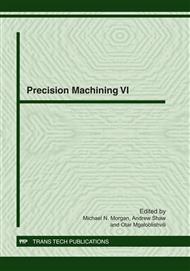p.188
p.194
p.200
p.205
p.211
p.217
p.223
p.229
p.235
Influential Parameters in Determination of Chip Shape in High Speed Machining
Abstract:
Cutting processes in machining involves the elastic and plastic formation where a layer of material is removed by a cutting tool to be removed from the workpiece in forms of various types of small chips. In this paper, a series of finite element simulations of 2D chip formation with various parameters are presented. Different types of chip shapes, such as continuous, discontinuous and serrated shape, are simulated under different conditions. A damage evolution technique based on fracture energy dissipation during material damage progression is used to demonstrate the influences on chip formation. It is concluded that the fracture energy in damage evolution is a crucial factor for the determination of chip shape. Further the influence of depth of cut and rake angle are considered in the simulations.
Info:
Periodical:
Pages:
211-216
Citation:
Online since:
December 2011
Authors:
Price:
Сopyright:
© 2012 Trans Tech Publications Ltd. All Rights Reserved
Share:
Citation:


